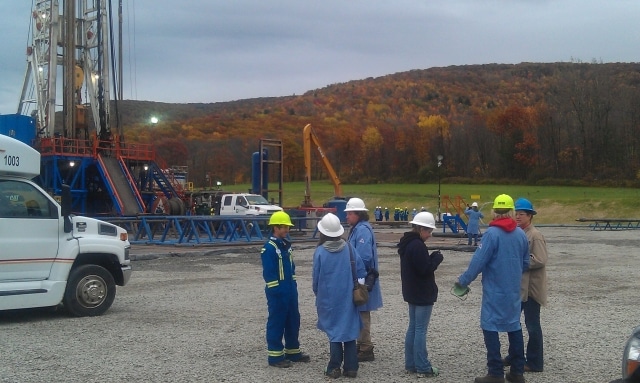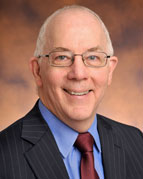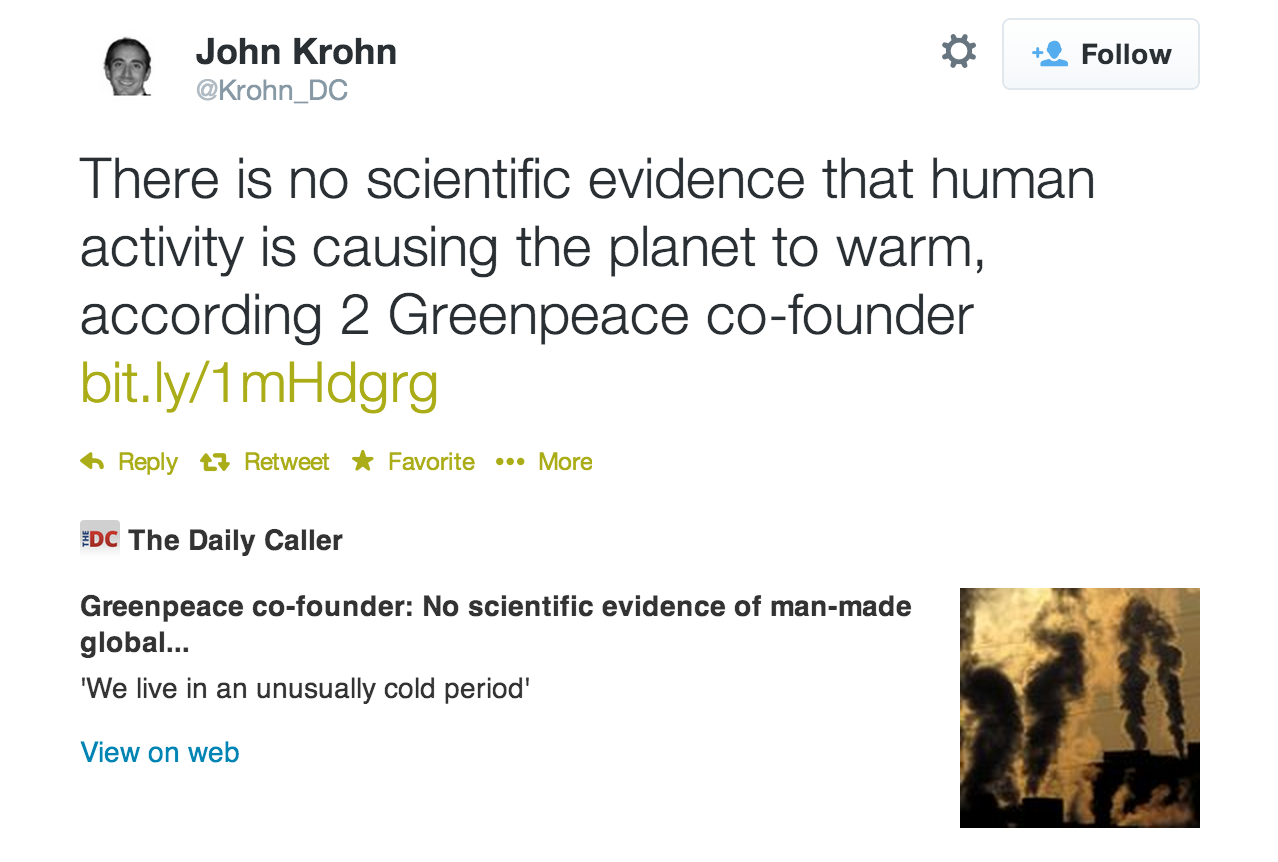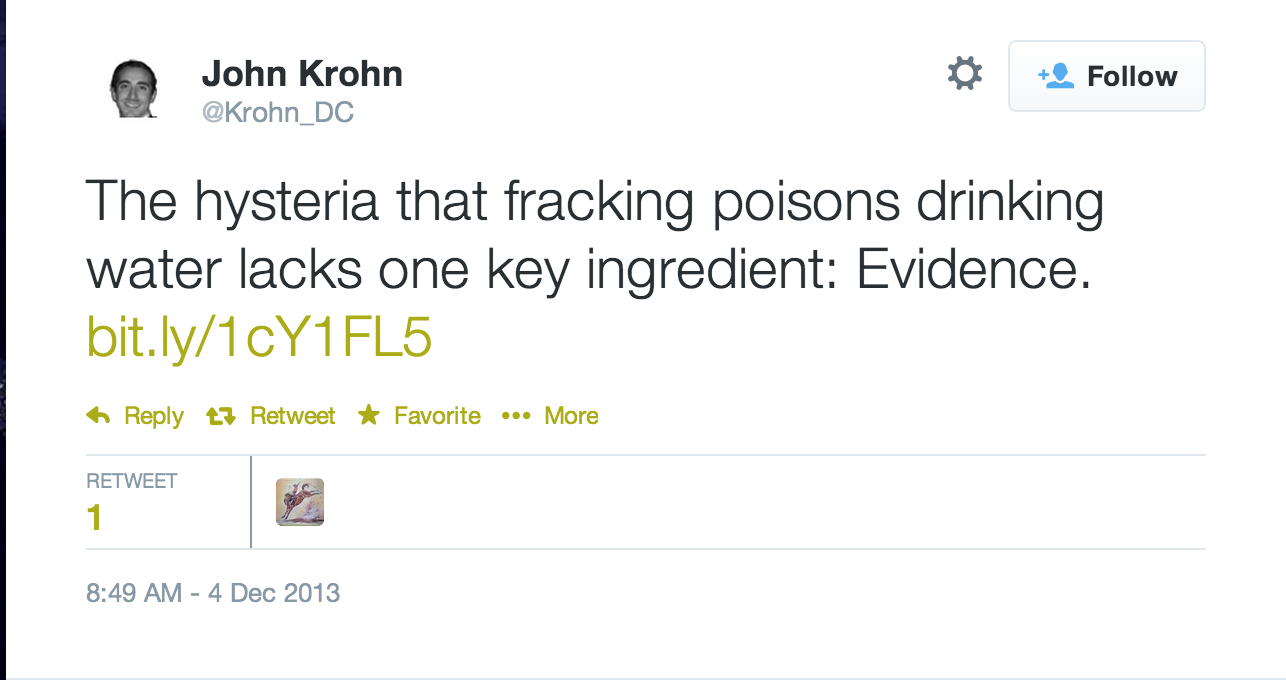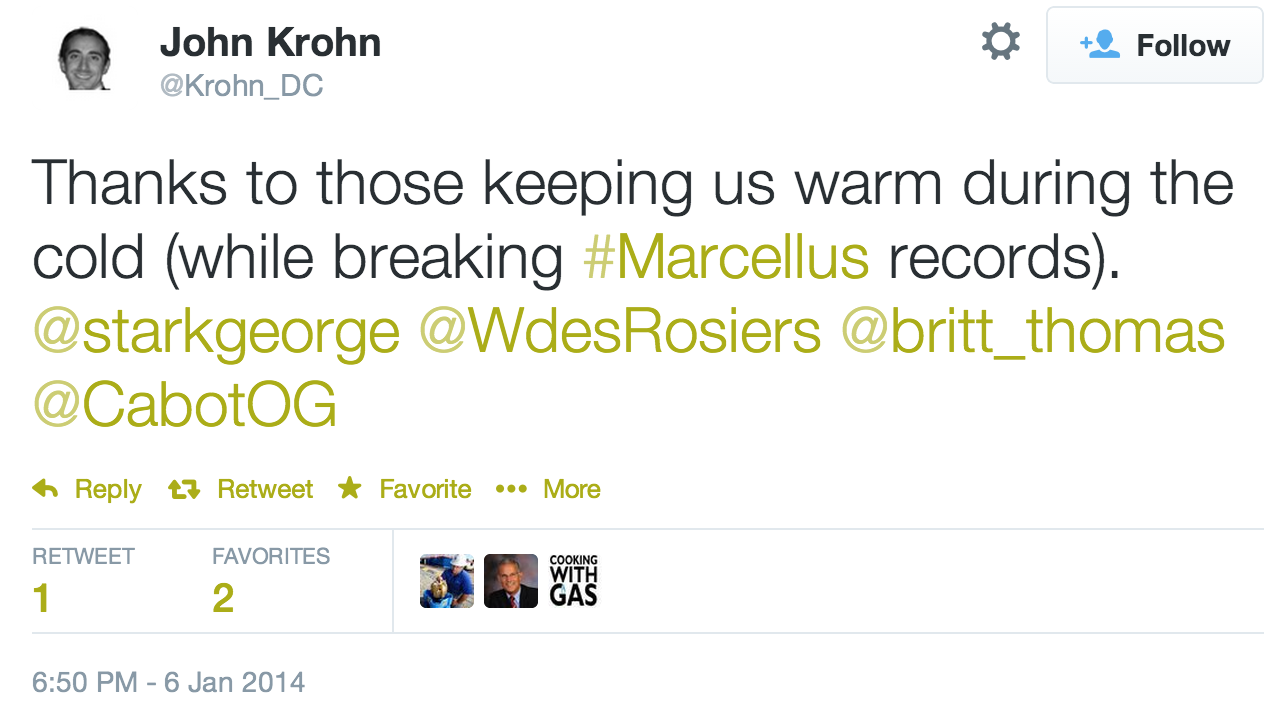For those familiar with U.S. Energy Information Administration’s (EIA) work, objectivity and commitment to fact based on statistics come to mind. Yet as Mark Twain once put it, “There are three kinds of lies: lies, damned lies, and statistics.”
That’s where John Krohn comes into play. A former spokesman for the gas industry front group Energy in Depth (EID), Krohn now works on the Core Team for EIA‘s “Today in Energy!“
Krohn has been at EIA since at least January 2014, when his name first appeared on the EIA website. On his Twitter account, he describes himself as an EIA communications manager.
As DeSmog revealed in February 2011, Energy In Depth was launched with a heavy injection of funding from oil and gas industry goliaths such as BP, Halliburton, Chevron, Shell and XTO Energy (now owned by ExxonMobil).
With its public relations efforts conducted by FTI Consulting, EID now serves as a key pro-industry front group promoting unfettered hydraulic fracturing (“fracking”) to the U.S. public.
Krohn follows in the footsteps through the government-industry revolving door of the man President Barack Obama named to head the U.S. Department of Energy (DOE) for his second term, former Massachusetts Institute of Technology “frackademic,” Ernest Moniz. DOE is the parent agency for EIA.
Further, EIA Administrator Adam Sieminski, another second-term appointee of President Obama, also passed through the same revolving door as Krohn and Moniz in his pathway to heading EIA. He formerly worked in the world of oil and gas finance.
“From 1998 to 2005, he served as the director and energy strategist for Deutsche Bank’s global oil and gas equity team,” his EIA biography explains. “Prior to that, from 1988 to 1997, Mr. Sieminski was the senior energy analyst for NatWest Securities in the United States, covering the major U.S. international integrated oil companies.”
Adam Sieminski, U.S. Energy Information Administration AdministratorU.S. EIA
The revolving door, though, is as American as apple pie. What makes the Krohn appointment more alarming to some observers: what this means in the context of the potential looming shale gas and oil bubble.
This revelation comes after EIA downgraded its Monterey Shale oil reserves estimate from 13.7 billion barrels to 600 million barrels, a 96-percent decrease
EIA: “Seriously Exaggerating Shale Gas Production”
In February 2013, Post Carbon Institute fellow David Hughes authored the report, “Drill Baby, Drill.” The report sounded the alarm about a potential looming bursting bubble if fracking proceeds at break-neck speed in order to meet investors’ expectations — as promoted by the oil and gas industry — of 100 years of recoverable shale gas and a “Saudi America” of oil.
Hughes, 40 years of experience as a geoscientist, says the productivity numbers coming out of wells around the country point to a far less rosy picture about the future of fracked oil and gas in the United States. The industry must maintain a constant “drilling treadmill” to ensure steady amounts of oil and gas come out of the ground.
David Hughes; Photo Credit: Post Carbon Institute
In an April article, Hughes said he believes EIA is “seriously exaggerating shale gas production.” His piece critiqued EIA‘s April “Drilling Productivity Report.”
“Production in February 2014, is stated to be more than 7.8 bcf/d higher in the EIA Drilling Productivity Report than it actually is…equivalent to more than 10 percent of the total gas production of the U.S,” wrote Hughes.
“Real production data usually lags two months behind, and the most recent months are subject to revisions. Yet the EIA’s Drilling Productivity Report confidently reports production for the current and following month.”
Krohn has also co-authored two articles for “Today in Energy!” painting a rosy picture of shale gas and oil production numbers — one a summary of EIA‘s March Drilling Productivity Report and the other a summary of EIA‘s Annual Energy Outlook 2014. In line with the rosy numbers and figures published by EIA, Krohn’s articles served to echo those findings.
“The productivity of oil and natural gas wells is steadily increasing in many basins across the United States because of the increasing precision and efficiency of horizontal drilling and hydraulic fracturing in oil and natural gas extraction,” reads the March article. “Many resource-producing basins are experiencing an increasing yield over time in either oil (Bakken, Eagle Ford, Niobrara) or natural gas (Marcellus, Haynesville).”
Hughes’ “Drill Baby, Drill” comes to far different conclusions about those fields. The day after Krohn’s article was published, Energy in Depth published an article citing and quoting from it.
“Critics of shale development have frequently alleged that the industry is a ‘bubble’ about to burst, owing to an alleged need to drill more and more wells to maintain production,” wrote Energy in Depth’s Dana Bohan. “But EIA’s latest report tosses cold water on that theory, demonstrating that technology is not static — unlike the bizarre musings of anti-fracking activists.”
Bohan did not respond to a request for comment for this article.
Krohn’s Track Record
Before coming to EIA, Krohn denied fracking has ever contaminated groundwater, promoted climate change denial, called for the U.S. Environmental Protection Agency not to act on fracking and berated New York Governor Andrew Cuomo for not ushering in fracking to his state.
Image Credit: Twitter Screenshot
Image Credit: Twitter Screenshot
Though his name has been removed from the website, Krohn also served as a media contact for “Truthland,” which served as EID‘s rebuttal to Josh Fox’s “Gasland.” His name still appears on an archived version of the website.
In between leaving EID and heading to EIA, Krohn was a self-described “consultant for major energy producers and energy coalitions.” Among those he did consulting work for: Natural Gas Now, a website and blog run by former EID-Marcellus Campaign Director Tom Shepstone.
Krohn has removed his resumé from his website, which also has no mention of his previous job at EID. Before his resumé was taken down, though, DeSmogBlog made a copy here.
Since coming to EIA, Krohn still maintains a pro-fracking stance on his Twitter account, which contains the “All opinions are my own” boilerplate language.
“North Dakota added more millionaires last year than any other state as #energy and #shale drive wealth in the state,” reads a January 17 tweet from Krohn. Another January tweet by Krohn gives a shout out to people on Twitter who work for the oil and gas industry for “keeping us warm during the cold.”
Both Krohn and the EIA have denied repeated requests for comment.
“Troubling” Hire
U.S. Public Law 95-91, Section 205, which created the EIA, suggests its reports should steer clear of policy prescriptions:
The [EIA] Administrator shall not be required to obtain the approval of any other officer or employee of the Department in connection with the collection or analysis of any information; nor shall the Administrator be required, prior to publication, to obtain the approval of any other officer or employee of the United States with respect to the substance of any statistical or forecasting technical reports which he has prepared in accordance with law.
Post Carbon Institute, which has been at the forefront of raising awareness about a prospective looming shale gas bubble, told DeSmogBlog it finds the hiring of Krohn “troubling.”
“The Energy Information Administration is viewed by government agencies — both here in the US and abroad — and media as the trusted source of energy information,” said Asher Miller, Executive Director of Post Carbon Institute. “It plays an invaluable role in determining energy policy, which is why it’s so troubling that the EIA would hire staff with a recent history of pro-industry propaganda.”
Photo Credit: Facebook; Krohn on the left at a fracking site while working at EID
Subscribe to our newsletter
Stay up to date with DeSmog news and alerts


